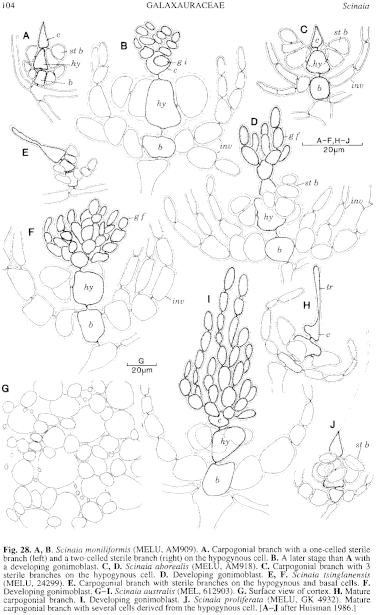|
|
|
|
|
|||||||||||
|
Electronic Flora of South Australia Species Fact Sheet
Phylum Rhodophyta – Class Florideophyceae – Order Nemaliales – Family Galaxauraceae
Selected citations: Millar 1990: 308, fig. 7G–I.
Synonym
Pseudoscinaia australis Setchell 1914: 121, fig. 62. Levring 1953: 511, fig. 42.
Thallus (Fig. 29A) medium red to red-brown, (5–) 10–20 cm high, subdichotomously branched every 0.4–3.5 cm, not constricted, branches 1–1.5 (–2) mm in diameter, apices pointed. Holdfast discoid, 1–2.5 mm across; epilithic. Structure multiaxial, developing a central core of entwined filaments 2–3 µm in diameter, from which radiate branched medullary filaments 2–4 µm in diameter, terminating in a cortex (Fig. 29B) of 2–4 ovoid, rhodoplastic, hypodermal cells 10–15 µm in diameter, and an outer layer of ovoid to pyriform colourless utricles, 18–30 µm in diameter, with numerous smaller utricles surrounding the larger ones in a rosette surface pattern (Fig. 28G).
Reproduction: Sexual thalli monoecious. Carpogonial branches (Fig. 2811) 3-celled, developing just below the hypodermal cells, with the hypogynous cell cutting off two sterile branches, 1-celled and 2-celled, and the basal cell producing sterile filaments which form the involucre after fertilization. Fertilized carpogonium cutting off initials which form a compact gonimoblast (Fig. 28I) with terminal chains of ovoid to pyriform carposporangia 10–14 µm long and 7–10 µm in diameter; fusion cell present. Cystocarps (Fig. 29C) 160–275 µm in diameter, ostiolate, with a well developed involucre. Spermatangial branches 2–4-celled, cut off from hypodermal cells with elongate cells penetrating between the utricles and cutting off clusters of ovoid spermatangia 2–3 µm in diameter, occurring in surface sori.
Type from Port Phillip Heads, Vic. (Wilson, 17.i.1893); holotype in UC, 74793.
Selected specimens: Port Stanvac, S. Aust., drift (Clarke & Engler, 6.iii.1980; AD, A50882). Port Elliot, S. Aust., drift (Gordon, 3.iii.1964; AD, A27451). Warrnambool, Vic., drift (Kraft, 11.ii.1984; MELU, 22999). Port Phillip Heads, Vic. (Wilson, 9.i.1886; MEL, 612903). R. Derwent, Tas. (Rodway, Jan. 1911; NSW, A3617). Collaroy, N.S.W., drift (May 1180, 1181, 8.xii.1945; NSW).
Distribution: Port Stanvac, S. Aust., to Woolgoolga Headland, northern N.S.W., and around Tasmania.
References:
HUISMAN, J.M. (1985). The Scinaia assemblage (Galaxauraceae, Rhodophyta): a re- appraisal. Phycologia 24, 403–418.
HUISMAN, J.M. (1986). The red algal genus Scinaia (Galaxauraceae, Nemaliales) from Australia. Phycologia 25, 271–296.
LEVRING, T. (1953). The marine algae of Australia. I. Rhodophyta: Goniotrichales, Bangiales and Némalionales. Arkiv för Bot. Ser. 2, 2, 457–530.
MILLAR, A.J.K. (1990). Marine Red Algae of the Coffs Harbour Region, northern New South Wales. Aust. Syst. Bot. 3, 293–593.
SETCHELL, W.A. (1914). The Scinaia assemblage. Univ. Calif Pubis Bot. 6, 79–153.
The Marine Benthic Flora of Southern Australia Part IIIA complete list of references.
Publication:
Womersley, H.B.S. (14 January, 1994)
The Marine Benthic Flora of Southern Australia
Rhodophyta. Part IIIA, Bangiophyceae and Florideophyceae (to Gigartinales)
Reproduced with permission from The Marine Benthic Flora of Southern Australia Part IIIA 1994, by H.B.S. Womersley. Australian Biological Resources Study, Canberra. Copyright Commonwealth of Australia.
Illustrations in Womersley Part IIIA, 1994: FIGS 28 G–I, 29 A–C.

Figure 28 enlarge
Fig. 28. A, B. Scinaia moniliformis (MELU, AM909). A. Carpogonial branch with a one-celled sterile branch (left) and a two-celled sterile branch (right) on the hypogynous cell. B. A later stage than A with a developing gonimoblast. C, D. Scinaia aborealis (MELU, AM918). C. Carpogonial branch with 3 sterile branches on the hypogynous cell. D. Developing gonimoblast. E, F. Scinaia tsinglanensis (MELU, 24299). E. Carpogonial branch with sterile branches on the hypogynous and basal cells. F. Developing gonimoblast. G–I. Scinaia australis (MEL, 612903). G. Surface view of cortex. H. Mature carpogonial branch. I. Developing gonimoblast. J. Scinaia proliferata (MELU, GK 4932). Mature carpogonial branch with several cells derived from the hypogynous cell. [A–J after Huisman 1986.]

Figure 29 enlarge
Fig. 29. A–C. Scinaia australis (A, UC, 74793; B, C, MELU, 22999). A. Holotype, habit. B. Cross section of cortex. C. Section of young cystocarp. D. Scinaia proliferata (MELU, GK 4932, holotype). Habit. E–G. Gloiophloea scinaioides. (E, LD, 32112; F, G, MELU, 22994). E. Holotype, habit. F. Cross section of cortex. G. Section of cystocarp. [A–D as in Huisman 1986; E–G as in Huisman 1985.]

|
Email Contact: State Herbarium of South Australia |

|